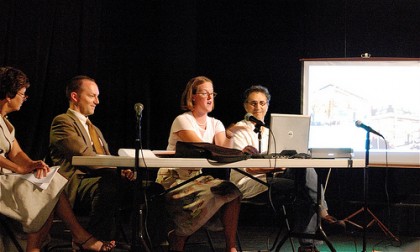RECENT COMMENTS
Conversation shows fault lines in city’s preservation process
Tonight’s conversation on the City Old & Historic Districts at the Firehouse Theater was an interesting public meeting on a process that has come under much criticism recently.
More than 100 people packed the Firehouse Theater, including 3 members of City Council (Squire, Samuels, Tyler) and citizens from many of the city’s neighborhoods. As might’ve been expected, the local civic organizations were heavily represented.
There are 15 districts and 29 individual sites identified as City Old & Historic Districts, encompassing over 3300 properties. The first of these was the St.John’s Historic District established in 1957. Exterior changes to architecture in the O&H districts is overseen by the Commission of Architectural Review.
The evening began with a review of the intent of the city’s Old and Historic district designation and the process by which the Commission of Architectural Review. Mimi Sadler, CAR Commissioner and partner in Sadler & Whitehead Architects, gave an overview “of the mission, mandate, and deliberative processes” of CAR. Elizabeth Tune of the Virginia Department of Historic Resources walked through the Secretary of the Interior’s Standards for Rehabilitation. David Johannas, CAR Chairman and partner in Johannas Design Group, gave a quick review of the standards utilized by CAR in reviewing proposed projects in City Old & History Districts (PDF).
Following the presentations, the floor was opened for commentary from the audience. The open mic brought to light citizen support and frustration with the O&H process. One of the speakers said that there are 3 groups of people involved in this process: CAR, City Council, and the folks that live in and appreciate old houses and historic neighborhoods. He spoke for the need for all of these groups to be on the same page to ensure that the historic architecture will be preserved. He and other speakers gave voice to the friction that some supporters of CAR have with different results of the process, including the design of new construction allowed in the O&H neighborhoods and the rigid interpretation of the guidelines.
A fourth group, opponents of City Old & Historic Designation, also had the time at the mic. Some asked hypothetical questions of how the designation would impact them or their neighbors. Others brought up the possible difficulties that lower-income neighbors might have in conforming to the guidelines. Scott Burger of Oregon Hill, a neighborhood on the State/National registers but not a City O&H, spoke to the fact that O&H designation would not protect Oregon Hill from growth by VCU.
The meeting agenda indicated that a second meeting will be scheduled to address specific issues/concerns.







There was some good information from the panel and a display from many who spoke that education about CAR and City Old and Historic Districts is needed. These meetings should help.
Harry Kollatz has write-up of the meeting on the Richmond Magazine site at Getting the Dance of Preservation Right.